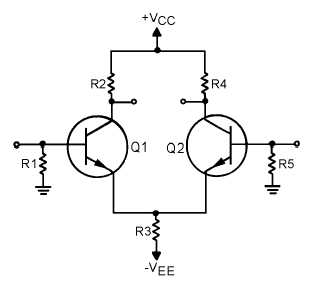3-11
Figure 3-6.—Differential amplifier.
Even though this circuit is designed to have two inputs and two outputs, it is not necessary to use
both inputs and both outputs. (Remember, a differential amplifier was defined as having two possible
inputs and two possible outputs.) A differential amplifier can be connected as a single-input, single-output
device; a single-input, differential-output device; or a differential-input, differential-output device.
Q-1.
How many inputs and outputs are possible with a differential amplifier?
Q-2.
What two transistor amplifier configurations are combined in the single-transistor, two-input,
single-output difference amplifier?
Q-3.
If the two input signals of a difference amplifier are in phase and equal in amplitude, what will
the output signal be?
Q-4.
If the two input signals to a difference amplifier are equal in amplitude and 180 degrees out of
phase, what will the output signal be?
Q-5.
If only one input signal is used with a difference amplifier, what will the output signal be?
Q-6.
If the two input signals to a difference amplifier are equal in amplitude but neither in phase nor
180 degrees out of phase, what will the output signal be?
SINGLE-INPUT, SINGLE-OUTPUT, DIFFERENTIAL AMPLIFIER
Figure 3-7 shows a differential amplifier with one input (the base of Q1) and one output (the
collector of Q2). The second input (the base of Q2) is grounded and the second output (the collector of
Q1) is not used.

